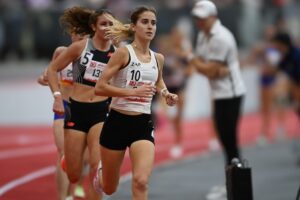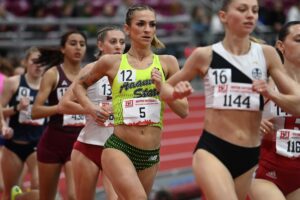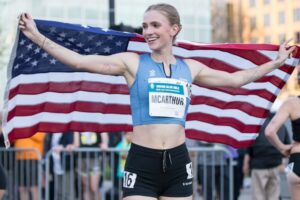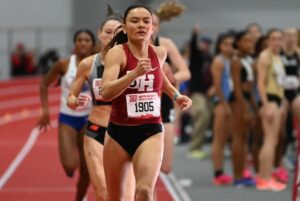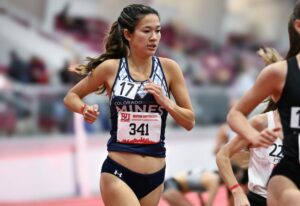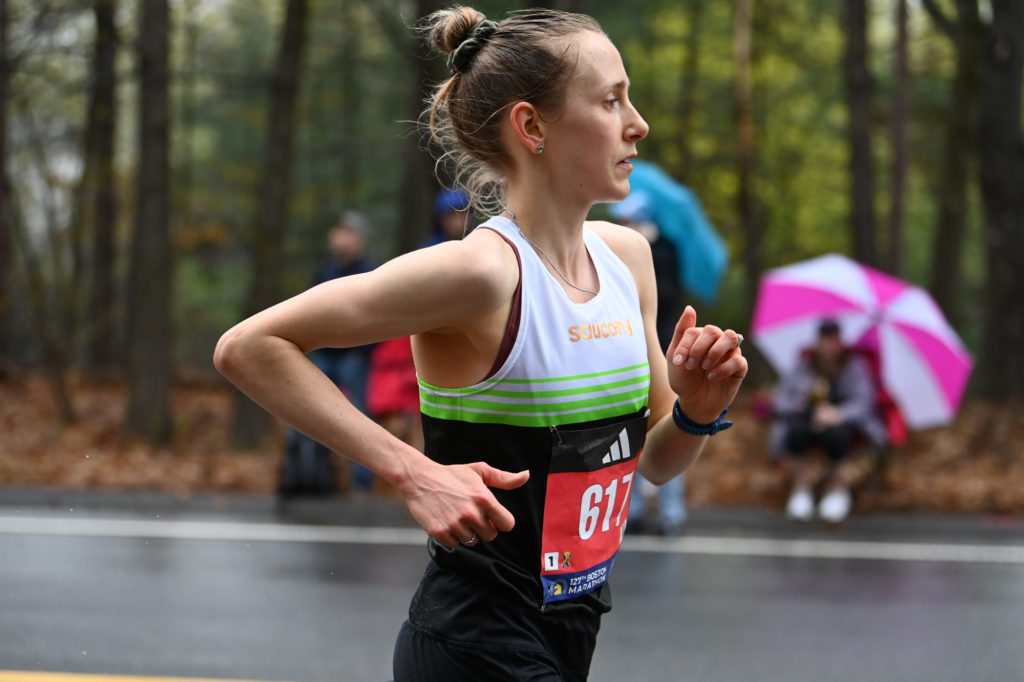
From the beginning of her running career, Anna Rohrer’s talent and willingness to push herself were evident. Her biggest challenge was staying healthy. She was a four-time national champion in high school and an eight-time All American for Notre Dame, but Rohrer’s successes were interspersed with a slew of injuries. After college, she tried to pursue professional running, but a back injury got in the way. By the spring of 2021, she was not sure if she’d ever be able to race at a high level again.
But over the past two years, Rohrer has been easing back into competition. At last month’s Boston Marathon, she wasn’t part of the professional field, but her time, 2:30:52, was fast enough to place her 22nd overall. She was the first woman from the mass start, and her time was a personal best by nearly six minutes. Nineteen days later, Rohrer won a half marathon in 1:11:31, another big PR. After years of frustration, Rohrer, 26, has figured out what works for her, and she’s able to dream big again.
High school standout
At the start of her sophomore year at Mishawaka (Indiana) High School, Rohrer made a massive leap from good state-level runner to one of the best in the country. That fall, she won her first national title at the 2012 Foot Locker Cross Country Championships. She attributes her jump to several things, including training with the boys’ team more often, and discovering an iron deficiency at the end of her freshman year—her ferritin level was 4 ng/mL—and correcting it.
Rohrer missed the cross country season her junior year after developing stress fractures in both the navicular bones in her feet. One was bad enough that she needed surgery, and she spent a stretch of time in a wheelchair. But she discovered that cross training kept her fit, and she worked her way back, winning the 5,000m at New Balance Nationals Outdoor in 2014. And as a senior, she repeated as Foot Locker champion and won another 5,000m title indoors.
She didn’t know it at the time—the term RED-S wasn’t coined until 2014—but Rohrer now thinks the bone stress injuries she suffered in high school could have been avoided with better fueling. In addition to working full-time as a mindset coach for business professionals, Rohrer has a side gig coaching runners, many of whom are in high school. Rohrer makes sure she talks to them about what fueling well looks like and, for the girls and women, the importance of getting regular periods.
“I don’t think it was really widely understood how the female body and nutrition and the menstrual cycle should be working together with high-level training, because women haven’t actually trained at this level for that long,” Rohrer said. “If you want proof that it’s a good thing to have a regular cycle, look at how many Olympians and professional women are having babies right now. They’re literally some of the best runners in the world, and I think they’re setting an awesome example in that way.”
Rohrer continued a similar pattern in her five years at Notre Dame, excellent performances followed by frustrating periods of injury. The injuries were different—including recurring pain in her back due to a bulging disc—but they were persistent. In spite of that, she had success, including running 31:58.99 for 10,000m, breaking a record previously held by American great Molly Huddle.
Rohrer graduated in 2020 and became a professional runner, joining the Boston Athletic Association’s High Performance Team that fall. But the back pain returned, and in the spring of 2021, she decided to leave the B.A.A. and take a break from competitive running, to let her body and mind heal.
A new chapter
After returning home to Indiana, Rohrer met with a doctor who told her she would probably continue having the same pain in her back if she kept doing what she was doing, and that surgery wouldn’t change that. “With that, I kind of just tried to go a different route,” Rohrer said. “I love running, I’m never going to just totally stop running. What I told myself was, ‘It will come back when it comes back.’ I just gave myself some time to heal and then slowly started running a little bit again.”
The itch to race came sooner than she was expecting, and she lined up for a 2021 Thanksgiving race, the Drumstick Dash in Indianapolis. Rohrer surprised herself, winning the 4.6-mile race in 23:49, which is 5:10 per mile. The following April, she ran 1:13:51 at the Carmel Half Marathon, her longest race to date. And the next month, she made her marathon debut, running 2:36:31 at the Green Bay Marathon and qualifying for the 2024 U.S. Olympic Marathon Trials.

Back to Boston
When Rohrer registered to run this year’s Boston Marathon, she didn’t bother to try to get into the elite field. “I was oblivious to what the elite field was,” she said. “I thought it was going to be all women running low 2:20s.”
In reality, she would have held her own. Starting with the masses had its pluses and minuses. The biggest negative was not having personal bottles along the course. Rohrer grabbed water, and occasionally Gatorade, every chance she could, knowing that she wouldn’t be able to take as much in as she would from a bottle. She carried some gels with her and grabbed additional ones along the course. It wasn’t ideal—she thinks she got a bit dehydrated, which might have affected her at the end.
But because she started with the masses, Rohrer had people to run with the whole way. And the company, all men, was a little more relaxed than she likely would have encountered in the elite field. As the top woman from the mass start, Rohrer got a lot of enthusiastic cheers along the course, and the crowds appreciated that she was assigned bib number 617, which is Boston’s area code.
The first half of the course was unfamiliar to Rohrer, but she knew the second half from her time living in Brighton, not far from the course. That was also where the race started to get tough. “I got to mile 23 and could tell I was slowing down, but I just tried to block it out,” Rohrer said, adding that the 25th mile was the toughest. “It felt like I was running 10:00 pace. I think I had one 7:00 mile in there, and the rest were like 6:00 and 6:30, so it wasn’t a crazy difference, but it did feel very significant at the time and I was just trying to stay focused and not panic.”
Rohrer ran the first half in 1:14:33 and the second half in 1:16:19. The performance vaulted her to a new level in the marathon, and she’s already thinking about where she can shave more time going forward. The best part, though, is that she hasn’t had back pain in nearly two years.
She told herself that if she got through Boston feeling okay, she could race the OneAmerica 500 Festival Mini-Marathon in Indianapolis, not far from her home in Carmel. And that’s how she ended up lining up again only 19 days after Boston and earning another PR. And now she will take a break before heading into another training block.
Finding what works
Through trial and error, Rohrer has discovered that her injuries have tended to come from doing fast speedwork on the track, as well as not giving herself enough recovery. In the past, she would push workouts harder than she should, even if she didn’t feel great, just to hit the times she wanted. Now she does more effort-based training.
If Rohrer wants to do mile repeats, she’ll run at mile effort on the roads for about five minutes. She’ll have a GPS watch running, so she can occasionally check her pace or find out what paces she hit after the fact. “That has allowed me to not overextend myself and get hurt,” she said. “I know what a pace should feel like. I’ve done it for like 15 years.” Rohrer has found effort-based training to be more enjoyable and less mentally taxing, too.
Leading up to her first marathon, Rohrer ran 65–70 miles per week. In the buildup to Boston, she pushed that to the mid to high 80s. “That’s what I had time for, with also working a full-time job,” she said. She’d like to do a little more the next time around, which she thinks will help her legs at the end of a marathon.
Rohrer has been leaning into her strengths, which includes doing long threshold and tempo workouts. And she has been replacing some of her hard speedwork with hills, where she can mimic the intensity she’d experience on the track without as much pounding. “The past two years have been experimenting with what is possible and what my body can do, instead of thinking about what I can’t do,” she said.
Rohrer is self coached, and for now, she likes it that way, because she feels like she has finally figured out how much she can handle. “I’m not opposed to having a coach in the future, but I don’t want to change anything right now because it’s been working,” she said.
Saucony has been providing Rohrer with gear and shoes. She doesn’t have a formal contract, but she’d love to receive more support going forward. For now, she has no plans to quit her job. “I think it helps me to not have running as my full focus,” she said. “When I put everything into it, I don’t think I can balance it as well.”
Rohrer says that her family, friends, and husband help keep her grounded. Rohrer married Nick Heiny last year. She has legally changed her last name to Heiny, but for now, she’s sticking with Rohrer in the running world. Heiny is not a runner, but sometimes he’ll accompany her on a bike during her runs.
Looking ahead
Other than the Olympic Marathon Trials, which will take place in Orlando, Florida, on February 3, 2024, Rohrer doesn’t currently have any races on her calendar. But she hopes to run another half marathon and marathon before the Trials. And she’d like to do some shorter races this summer.
In her next marathon, Rohrer would like to see how close she can get to the Olympic standard of 2:26:50. “I know it’s like a good four minutes to drop,” she says. “But I just dropped six, so who knows?”
Rohrer hasn’t thought too much about the Trials yet, but like most who line up for a shot at making an Olympic team, she has thought about what it would be like to qualify for Paris 2024. But she’s remaining focused on the present.
“I think of the big goal, and then I think of what’s possible with a stretch—never just what’s possible, but what’s possible, and then push a little further than that,” Rohrer says, sounding like the mindset coach she is. “And then I return to the present and think about what I need to do today to get as close to that outcome as I can.”

